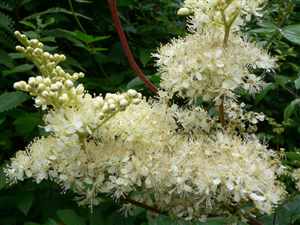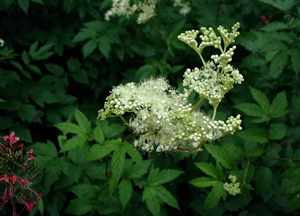Meadowsweet (Filipendula ulmaria)
Main Facts about Meadowsweet

Meadowsweet is a perennial plant that grows 3-4 feet (0.9-1.2 m) high in damp water meadows and on river banks, earning its old country name, Queen-of-the Meadow. It was once called Meadwort, as it was used to flavor mead, and in Chaucer’s England it was made into beer.
Meadowsweet has elm-like leaves and large clusters of almond-scented, creamy white flowers that bloom from June to September. The leaves smell like wintergreen when crushed.
Parts used – flowers, leaves, and roots.
This plant is native to Europe and Asia and has been naturalized throughout North America.
Meadowsweet was revered as a sacred herb by ancient Celtic Druid priests as early as 600 B.C. and was mentioned in English herbal guide books dating to the 16th century. A tea made from the herb’s flowers and leaves was used to treat feverish colds and to alleviate pain in muscles and joints.
Aspirin, one of the world’s most common and important drugs, was developed from the Meadowsweet plant. In 1839, the compound salicylic acid was identified from its flower buds and became widely used to treat pain, fever, and inflammation – but one side effect was an upset stomach.
In 1853, German chemists added a molecular acetyl group to a Meadowsweet extract and synthesized acetylsalicylic acid, which provided greater relief from fever, pain, and inflammation. The name chosen for the new compound was “aspirin” – a combination of “a” for acetyl and “spirin” for “spiraea”, the former name of the Meadowsweet plant. In 1899, the company Bayer AG began to sell a synthetic form of this compound.
The herb is considered less irritating to the stomach than the purified drug.
Using Meadowsweet
The medicinal action of Meadowsweet naturally resembles that of aspirin without the side-effect of stomach irritation. Meadowsweet is a well-known remedy for arthritis and rheumatism. Its diuretic action helps eliminate excess fluid and toxins from the body and its analgesic action soothes pain, not only joint pain but also headaches and neuralgia.
Meadowsweet contains aspirin-like compounds that are responsible for its pain-relieving and anti-inflammatory properties. These compounds can also help to bring down fevers, so this herb is often recommended for the treatment of colds and flu.
Meadowsweet contains astringent tannins that can help relieve diarrhea. In fact, Meadowsweet, taken internally, is actually an excellent remedy for a whole range of digestive disorders, including acidity, gastritis and ulcers. It has an antiseptic as well as anti-inflammatory action.
Meadowsweet has a balancing effect on acid production in the stomach as well as a soothing and healing effect on the upper digestive tract To make an infusion: use 1-2 tsps of dried, powdered herb per cup of boiling water. Steep for 10 min and strain. Drink up to 3 cups a day.
Meadowsweet is a remedy for: Cold and flu, Arthritis
Cooking with Meadowsweet
The flowers are used to flavor jams, stewed fruits and wine as well as mead and the non-alcoholic Norfolk Punch.
When added to cooked fruits and jams, the flowers give it almond flavor.
How to grow Meadowsweet

If the foliage becomes tattered, cut the plants to the ground and fresh leaves will emerge.
Harvest the leaves and flowers when the plant is in bloom.
| Marshmallow |
Mimosa
|